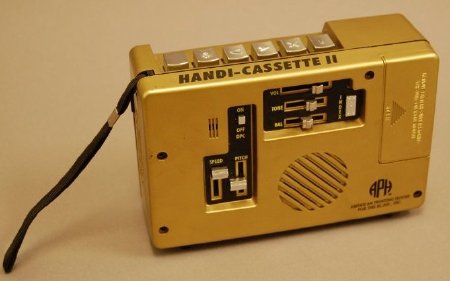Object ID:
2010.30.8
Title:
Handi-Cassette II Recorder/Player prototype
Description:
Fully-functional prototype of the compact audiocassette tape recorder/player. gol-painted plastic exterior with four rubber rests on the bottom corners and a black, nylon carrying strap. Located on the speaker panel: a push-button tone-indexing control, on/off switch, 4-AA battery compartment with sliding removable cover, and sliding controls for VSC (variable speech control) speed, VSC pitch, volume, tone and balance. A cassette compartment, featuring a tape-sensing window of clear plastic, is located on the opposite side panel, along with control switches for selecting 15/16 or 1 7/8 ips, stereo or mono, and the track. Push-button controls for record, play, rewind, fast forward, stop/eject, and pause are located along the top edge. Controls and switches are tactually distinguishable. Jacks for stereo headphone, remote control, external microphone, and external (6V DC) power are located on one end. At opposite end, molded in the plastic: "Model no. 8168." APH logo and company name appear in black lettering on the speaker side.
Dimensions:
H-4.625 W-7 D-2.375 inches
Date:
ca. 1996
Made by:
American Printing House for the Blind
Place of Origin:
Louisville, KY/China
Collection:
APH Collection
Provenance:
A gold and a chrome prototype were given to APH President Tuck Tinsley by Aaron Shrenker, owner and sales representative of Electronic Component Services, a company that APH worked with in the development of the Handi-Cassette II model. These were the first two fully-functional units made.
The Handi-Cassette II was introduced in 1996 as the "next generation" of the Handi-Cassette Tape Recorder/Player. APH employees Bob Phelps and James Robinson were the lead people in the product's design and development. Digital pitch control was added in 2000.
The Handi-Cassette II was introduced in 1996 as the "next generation" of the Handi-Cassette Tape Recorder/Player. APH employees Bob Phelps and James Robinson were the lead people in the product's design and development. Digital pitch control was added in 2000.
